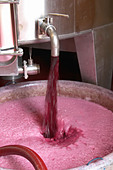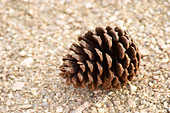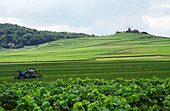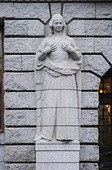At this time of the year we start thinking of what port wines we might find in our cellar, to bring up to the table for the festivities. This year we already know exactly which port we will have. This summer we brought home (to Paris) the wine cellar that we have had resting in Stockholm since we moved to Paris. That’s twenty years ago (! ooh) so the wines resting up north have generally reached maturity, if not more. We suspect that some will be best described as “interesting”. But that’s one of the charms with wine. The wine might be too old, passed its peak, but it is still interesting – an experience.
When we were putting all the bottles down in boxes in Sweden we noticed one bottle of port with a cork that had leaked a little bit. When we looked closer at the by then standing bottle it even looked as if the cork would be falling down into the wine. But we didn’t much fancy finishing a full bottle of old port in the heat of summer so we packed it up and brought it home. We’ve had it waiting in a cool place ever since – waiting for Christmas. We bought the bottle long ago, when they were still allowed to export the port in bulk and bottle at the destination. This wine had been bottled by the then monopoly importer in Sweden, Vin & Sprit (the lost their monopoly in 1995 and were recently acquired by Pernod Ricard. Now we’re just waiting for the retail monopoly, which still exists, to disappear. We might have to wait for a long time). That was the time when you could buy a bottle of vintage port in Sweden for less than ten euro. Bottled in Stockholm. What port it is? It’s an Offley Boa Vista 1962. Wonder how it will turn out. If we get the cork out OK!
But we would also like to suggest that you try some other kind of sweet wine for Christmas. It’s one of the few times you (we) really indulge in these sweet wines. At other times one has far too few occasions to drink them. There are many other exiting sweet wines to try: Try for example a Vin Doux Naturel (VDN) wine from the south of France: Banyuls, Rivesaltes, Muscat of different kinds (Frontignan, Mireval, Lunel, Beaumes-de-Venise… There’s even a special cuvée called Muscat de Noël!), Maury, and so forth. An interesting point is that these wines are often made in a way that is close to the way that port is made: you let the must ferment for a short time and then you add grape alcohol. Madeira, that exists in very many different styles, some which are lusciously sweet. Sherry, even if the ones that we long most for are the really, really dry styles they do make excellent sweet wines. The most extreme is the one called pedro ximenes, made from the grape of that name. It’s almost syrupy. Definitely a Christmas sweet all in itself. Or a Moscatel de Setubal from Portugal, with a lovely sweet muscat perfume.
Or you can go down a bit in alcohol contents and drink some “naturally” sweet wines, without added alcohol. Sauternes, of course, or you could try one of the neighbouring districts, less famous but also less expensive: Loupiac, Cadillac…; or a lovely sweet Jurançon with a vibrant fresh acidity, if you can find one, they’re quite rare, but quite good! A Vin Santo from Italy perhaps, which would give you reason to munch on some almond cookies too; an ice wine from Germany or Austria, or less extreme, an auslese; or if you want to be really exotic you could try a sweet Jura wine, Vin de Paille (or the rare, and dry, Vin Jaune).
There is plenty to choose from. And if you don’t have any of that in your cellar, perhaps it can be something to hope that Father Christmas brings in the stocking. Or you could give it to someone else, who might share it with you. Or you could come over to our place and help us finish the Boa Vista!
In any case, we hope that the festive season will be an occasion for you to try many new wines – be they sweet or not. We will certainly keep the cork screw busy over Christmas.
Britt & Per
PS: Recommend to your friends to read the Brief or forward it to them !
More on wine:
Get the full BKWine Brief here for free! 

 Read more...
Read more...
 Vinisud is one of the big wine shows. It is primarily focused on the professional visitor / wine buyer. It is a very interesting wine show, not least because there are plenty of small producers, much more than e.g. at a grand show like Vinexpo. One of the reasons is that it is relatively cheap to have a stand so smaller producer can afford it. They also focus on the wine regions around the Mediterranean, where there are many small / mid-size and interesting producers today. The Languedoc-Roussillon has the largest number of exhibitors, not surprising since it takes place in that region. But also for example the Rhône Valley as well as some other countries around the Mediterranean are well represented. This year there will even be an exhibitor from Greece. In spite of “the crisis” the numbers point towards at least as many exhibitors as last time. It’s certainly an interesting show for those who are looking to establish new contacts with producers. Well worth visiting if you’re interested in this type of wines. And who’s not? BKWine will certainly be there! Facts: 22-24 February 2010 in Montpellier. More info: www.vinisud.com
Vinisud is one of the big wine shows. It is primarily focused on the professional visitor / wine buyer. It is a very interesting wine show, not least because there are plenty of small producers, much more than e.g. at a grand show like Vinexpo. One of the reasons is that it is relatively cheap to have a stand so smaller producer can afford it. They also focus on the wine regions around the Mediterranean, where there are many small / mid-size and interesting producers today. The Languedoc-Roussillon has the largest number of exhibitors, not surprising since it takes place in that region. But also for example the Rhône Valley as well as some other countries around the Mediterranean are well represented. This year there will even be an exhibitor from Greece. In spite of “the crisis” the numbers point towards at least as many exhibitors as last time. It’s certainly an interesting show for those who are looking to establish new contacts with producers. Well worth visiting if you’re interested in this type of wines. And who’s not? BKWine will certainly be there! Facts: 22-24 February 2010 in Montpellier. More info: www.vinisud.com































